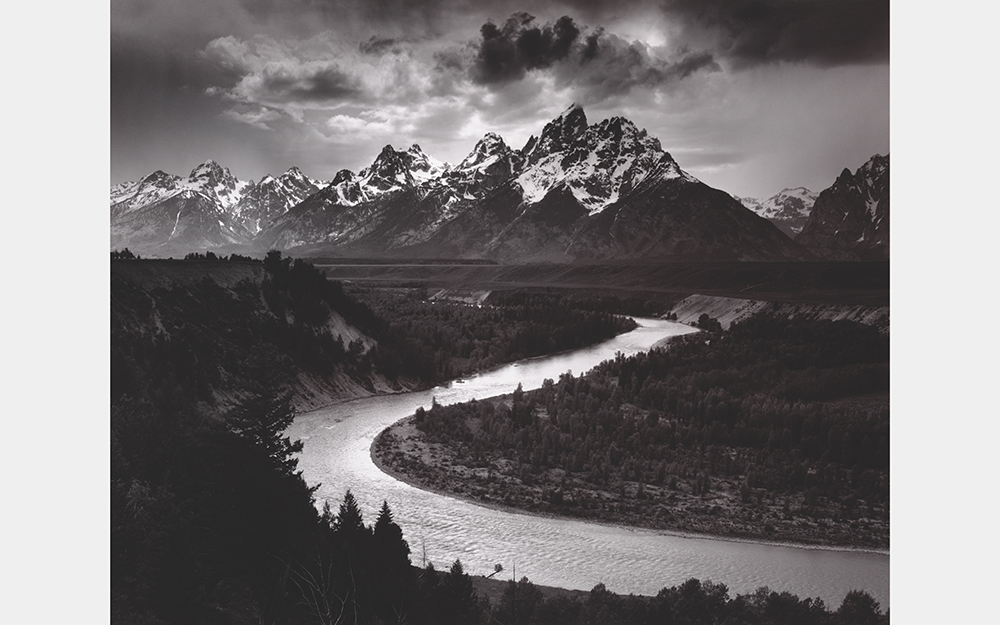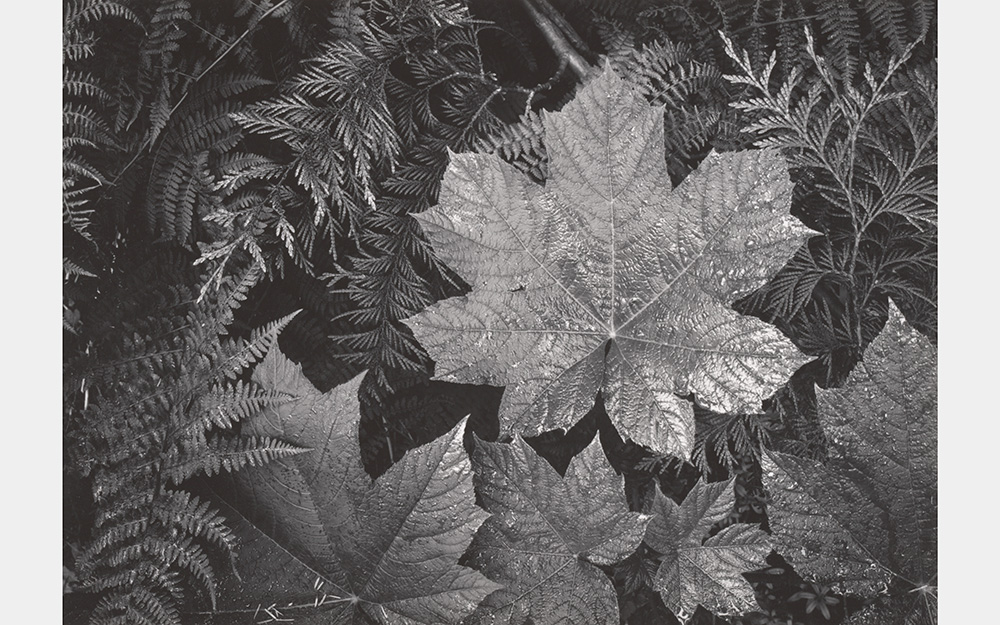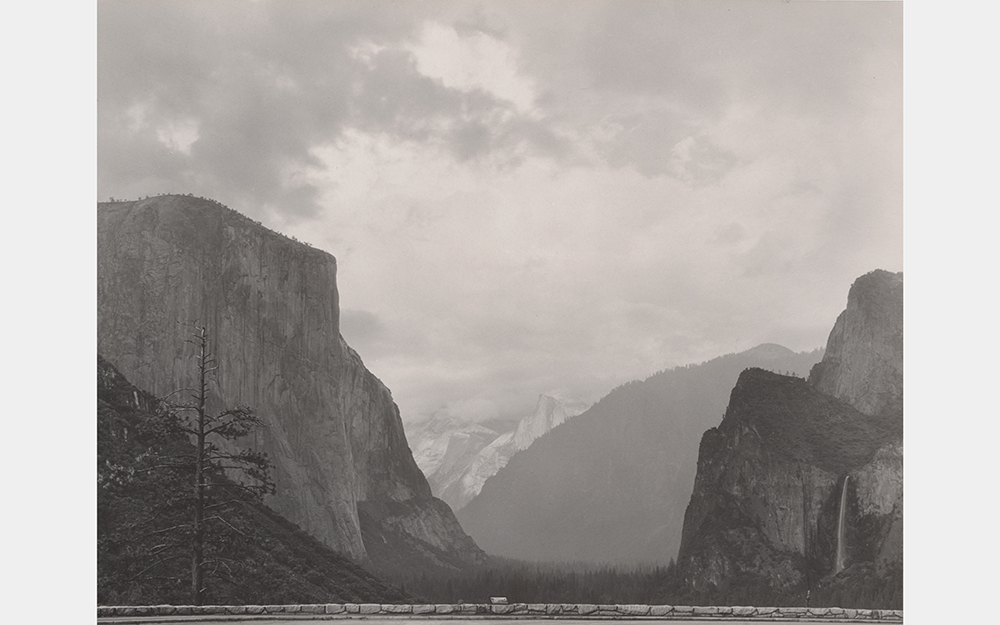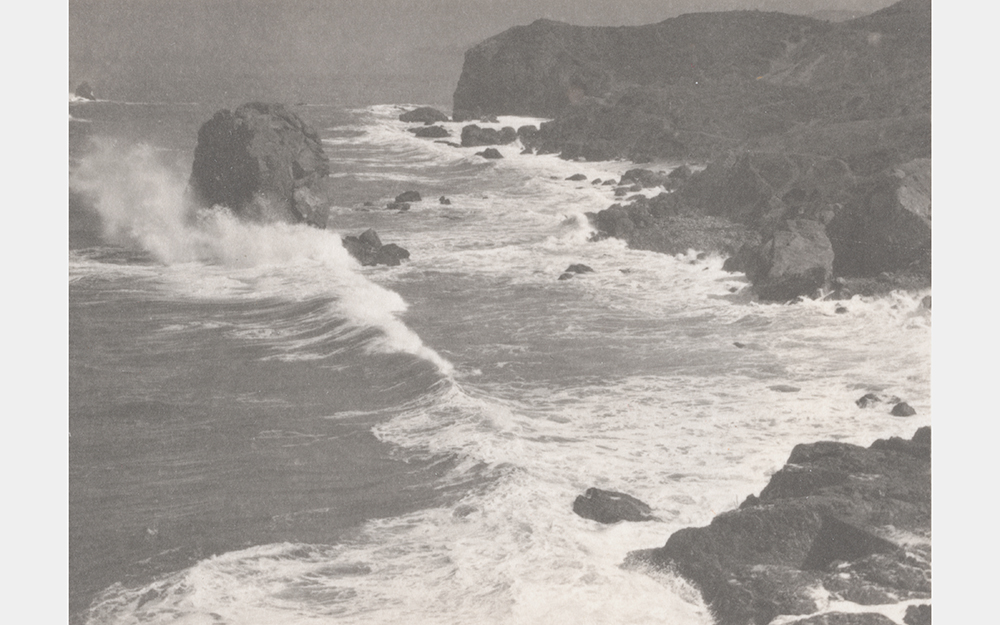- Art
- Exhibitions
- Farm to Table: Food and Identity in the Age of Impressionism
- Cycle Thru! The Art of the Bike
- Tintoretto’s Genesis
- Upcoming Exhibitions
- Online Exhibitions
- Special Features
- Past Exhibitions
- Explore the Collection
- Provenance and Cultural Property
- Conservation
- Meet the Curators
- Digital Resources
- Art Bridges Cohort Program
Discovering Ansel Adams
September 27, 2024–January 19, 2025
The Thomas R. Schiff Gallery (Gallery 234 & 235)
Ticketed. Free for Members. Save $2 when purchasing tickets online.
Adult tickets: $12 in-person, $10 online
Seniors, college students and children 6–17 years: $8 in person, $6 online
Children 5 years & under: free
Friends of Photography
Press Release
Extended Hours During Final Days of Discovering Ansel Adams
Due to popular demand, the Cincinnati Art Museum is extending its open hours so that as many visitors as possible can see the exhibition before it closes Sunday, January 19!
Thursday, January 16:
Open until 9 p.m. (regular closing time is 8 p.m.). Discovering Ansel Adams is free between 5–9 p.m. No tickets required.
Friday, January 17:
Open 11 a.m.–7 p.m. (regular closing time is 5 p.m.)
Saturday, January 18:
*Extended members-only hours 9–11 a.m. (regular members-only hour is 10–11 a.m.)
Open to the public 11 a.m.–7 p.m. (regular closing time is 5 p.m.)
Sunday, January 19:
*Extended members-only hours 9–11 a.m. (regular members-only hour is 10–11 a.m.)
Open to the public 11 a.m.–7 p.m. (regular closing time is 5 p.m.)
*Not a member? You’re welcome to attend during this timeframe if you purchase a museum membership. (This is also a great time to get a good parking spot!)
Premiering at the Cincinnati Art Museum, Discovering Ansel Adams provides an unprecedented exploration of the early career of Ansel Adams (1902–1984), demonstrating how, between 1916 and the 1940s, Adams developed from a 14-year-old tourist with a camera into America’s most celebrated photographer. Drawn from the definitive Adams collection at the Center for Creative Photography, Tucson, the exhibition brings together approximately 80 virtuosic photographs with unique ephemera including the artist’s handwritten correspondence, snapshots, personal possessions, and photographic working materials. Featured works range from small, one-of-a-kind photographs from Adams’s teenage years to jaw-dropping mural-sized prints of his most iconic mature views. Join the artist on his journey from teenage musician to young mountaineer, as he makes his first pictures at Yosemite, experiences the American Southwest, learns how to communicate with a broad national audience, and undertakes an epic quest to photograph America’s national parks. Along the way, discover how Ansel Adams became Ansel Adams.
Founded in 1975 by the President of University of Arizona and Ansel Adams, the Center for Creative Photography is one of the world’s finest institutions for the study of the history of photography, and a singularly important archive for Ansel Adams studies. Discovering Ansel Adams presents a rare opportunity to encounter the CCP’s Ansel Adams collection outside of Arizona.
Accessing the Exhibition
Elevators A and B provide the most direct access to this second floor exhibition. Visitors may enter and exit the exhibition via short stairways or via a ramp, located in Gallery 234. Seating is provided within the exhibition gallery. Large print label booklets are available in the gallery and online. Audio of select exhibition interpretation is available online and on the Bloomberg Connects app. For fidgets, social narratives, sensory headphones, and other tools, visit the CAM Access Cart. The Access Cart is located in Schmidlapp Gallery just beyond the museum’s front lobby.
Visitor Tips
- The exhibition does not have timed entry. Give yourself plenty of time! All ticket purchasers will get to see the exhibition, but you might have to wait in line (enjoy our collection in the neighboring galleries while you wait!). Plan for an extra 30+ minutes just in case you arrive during a peak time.
- Parking may be limited. If museum parking lots are full, consider offsite parking. Rideshares and public transportation are great options, too!
- Wear your walking shoes! Not just for the museum – but for walking to/from your car. Remember there could still be snowbanks and closed sidewalks. Please be careful and dress comfortably!
- Dress accordingly as temperatures throughout the museum may vary.
- The exhibition is ticketed. Free for members. Save $2 when purchasing tickets online. Adult tickets: $12 in-person, $10 online; Seniors, college students and children 6–17 years: $8 in person, $6 online; Children 5 years & under: FREE.
After the Cincinnati Art Museum, Discovering Ansel Adams will be presented at the Oklahoma City Museum of Art from June 7–September 28, 2025. Please visit their website for more information.
Featured Media
 Perspectives
Perspectives
Watch Ansel Adams reflect on the making of one of his most-loved pictures.
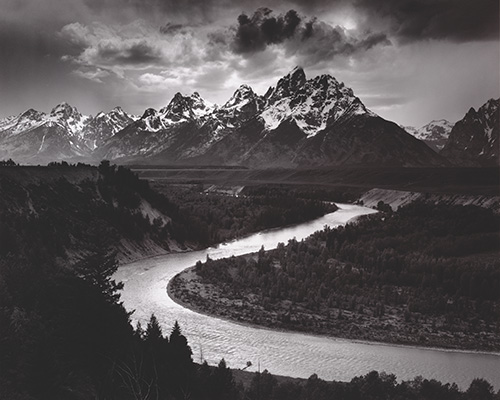 Survey
Survey
Share your feedback about the exhibition.
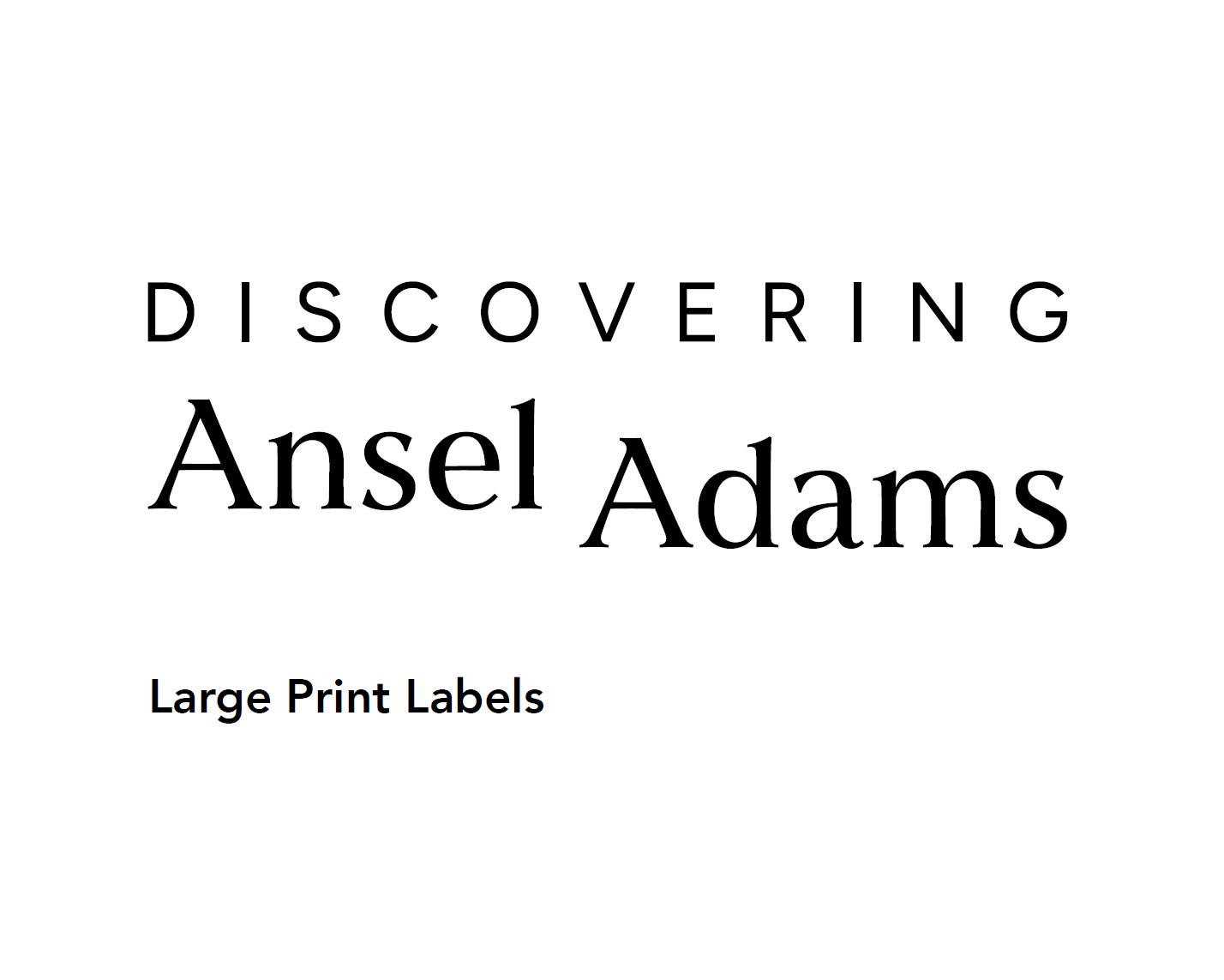 Exhibition Content
Exhibition Content
Download complete Ansel Adams large print labels, optimized for screen reader. Large print labels are also available in print in the gallery.
 Video
Video
Watch Curators in Conversation—Discovering Ansel Adams.
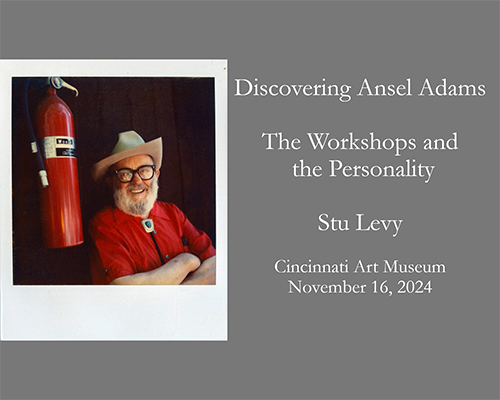 Perspectives
Perspectives
Cincinnati-born photographer Stu Levy shares his Ansel Adams story in a special edition of CAM’s Gallery Talk Plus program.
Members Opening
Thursday, September 26, 5–7 p.m.
Sold Out – CAM Presents: Discovering Ansel Adams—Curators in Conversation
Thursday, September 26, 7–8 p.m.
CAM Kids Day: Landscapes in the Lens
Saturday, October 5, 10 a.m.–3 p.m.
Create Plus: Discovering Ansel Adams
Saturday, October 19, 1–4 p.m.
Art After Dark
Friday, October 25, 5–9 p.m.
Sold Out – Gallery Talk Plus: Discovering Ansel Adams with Stu Levy
Saturday, November 16, 1–3 p.m.
Ansel Adams Collecting & Connoisseurship Workshop with Dr. Rebecca Senf
Friday, January 10, 2025, 9:30 a.m.–2 p.m.
True American Landscapes: Ansel Adams and Civil Rights
Sunday, January 12, 2025, 2–3 p.m.
Audio Exhibition
Hear interpretive content for the exhibition, wherever you are.
Exhibition Playlist
Ansel Adams was an avid musician throughout his life. He even met his wife, Virginia Best Adams, while practicing on the piano in her father’s Yosemite art studio. Click below to hear a playlist selected from composers represented in Adams’s sheet music collection. Whether you listen in the Discovering Ansel Adams exhibition gallery or at home, consider how Adams’s expressive imagery relates to his lifelong love of music.
 Making a Photographer: The Early Work of Ansel Adams
Making a Photographer: The Early Work of Ansel Adams
An unprecedented examination of the early career of one of America’s most celebrated photographers, by Dr. Rebecca A. Senf.
Published by Yale University Press in association with the Center for Creative Photography at the University of Arizona, 2020. 288 pages, 175 color illustrations.
One of the most influential photographers of his generation, Ansel Adams (1902–1984) is famous for his dramatic photographs of the American West. Although many of Adams’s images are now iconic, his early work has remained largely unknown. In this first monograph dedicated to the beginnings of Adams’s career, Rebecca Senf argues that these early photographs are crucial to understanding Adams’s artistic development and offer new insights into many aspects of the artist’s mature oeuvre.
Drawing on copious archival research, Senf traces the first three decades of Adams’s photographic practice—beginning with an amateur album made during his childhood and culminating with his Guggenheim-supported National Parks photography of the 1940s. Highlighting the artist’s persistence in forging a career path and his remarkable ability to learn from experience as he sharpened his image-making skills, this beautifully illustrated volume also looks at the significance of the artist’s environmentalism, including his involvement with the Sierra Club.
Thank you for your stories. Submissions are now closed.
Have you met Ansel Adams? Did you learn from him? Have his pictures or writings featured meaningfully in your life?
The Ansel Adams Archive at the Center for Creative Photography wants to hear about your encounter with Adams and his work—and preserve your story for future historians.
Organized by the Center for Creative Photography, University of Arizona, with the support of The Museum Box.
Discovering Ansel Adams is a Featured Project in the 2024 FotoFocus Biennial: backstories. Now in its seventh iteration, the Biennial activates over 100 projects at museums, galleries, universities, and public spaces throughout Greater Cincinnati, Dayton, Columbus, and Northern Kentucky in October 2024—the largest of its kind in America. The backstories theme focuses on stories that are not evident at first glance. They offer context for what happened previously or out of view, providing narratives not yet told or presented from a new perspective. Once told, they shed light on current circumstances.


Support for this 2024 FotoFocus Biennial Featured Project was provided in part by FotoFocus.

Presented by
Additional exhibition support provided by



